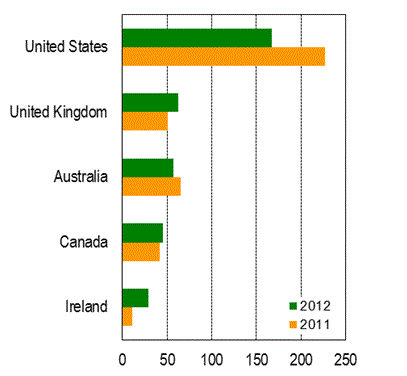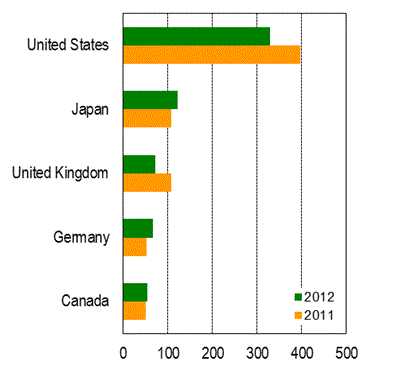Inflows of foreign direct investment (FDI) to the world’s 38 developed economies fell in aggregate by 32 per cent to US$561 billion in 2012, although this decline was exaggerated by changes in intra-company loans across borders, the World Investment Report 20131 reveals.
The report, which is subtitled Global Value Chains: Investment and Trade for Development, was released today.
Inflows to developed economies had been on an upward trend after having bottomed out in 2009, but the sharp contraction in 2012 reversed all of the ground regained in 2010 and 2011. In aggregate, developed economies’ share in global FDI inflows fell from 50 per cent in 2011 to 42 per cent in 2012.
By region, the decline was most pronounced in Europe, where inflows diminished by 42 per cent to a level equivalent to just over one third of the peak reached in 2007. Inflows to North America fell by 21 per cent. In the Asia-Pacific region, although Japan’s inflows turned positive after two successive years of net divestment, Australia and New Zealand saw inflows decline by a combined 14 per cent.
At the level of individual economies, inflows were down in 23 countries, including the two largest recipients in 2011, Belgium and the United States. A number of countries, however, confounded the general downward trend. For instance, the United Kingdom saw its inflows extend their recovery, rising by 22 per cent (figure 1).
Uncertainty created by the continuing Eurozone crisis, the prospect of political transition in a number of major countries, and a slowdown in the commodities boom were among key factors contributing to subdued FDI in 2012. Given the uncertain economic outlook, many transnational corporations (TNCs) chose a strategy of consolidating their assets with a view to focusing on core businesses and geographic areas, which resulted in a large number of divestments. In particular, the restructuring of the financial industry, which began in the aftermath of the global financial crisis, continued in 2012.
Two further factors had important effects on FDI flows. One is the increasingly complex cross-border corporate structures of TNCs, which are often put in place with the aim of reducing tax liabilities. With record levels of reinvested earnings, these corporate structures have been responding to varying national tax systems by transferring profits and loans across borders, sometimes inflating and at other times deflating FDI flows dramatically. The second factor is the activities of various investor funds that have acquired distressed assets at discounts and have restructured them. When the restructuring is complete, the assets are sold off. Thus, cross-border acquisitions by these investment funds generate FDI but are followed by divestment, which has the effect of bringing down the value of FDI – as was the case in 2012.
Outflows of FDI from developed economies declined even more markedly than inflows, falling by 23 per cent to $909 billion. The decline in outflows from developed countries accounted for almost all of the reduction in global outflows in 2012. As a result, the share of developed countries in global outflows fell to 65 per cent. Outflows from European countries, which declined by 37 per cent, came to less than one third of the peak reached in 2007. Outflows from the United States, which had been driving the recovery of FDI in developed countries, also saw a large decline (down 17 per cent). FDI outflows from Japan, however, kept up the momentum of the previous year and grew by 14 per cent to reach $123 billion in 2012, thus maintaining the country’s position as the second-largest investor in the world.
Overall, outflows declined in 22 developed economies, including four of the top five investor countries in 2011 (figure 2). Among the countries that bucked the trend were Canada, Germany and Japan.
Figure 1. Top 5 recipients of FDI flows in developed countries, 2011 and 2012
(billions of US dollars)
Source: UNCTAD. World Investment Report 2013.
Note: Countries are ranked on the basis of magnitude of 2012 FDI flows.
Figure 2. Top 5 investors from developed countries, 2011 and 2012
(billions of US dollars)
Source: UNCTAD. World Investment Report 2013.
Note: Countries are ranked on the basis of magnitude of 2012 FDI flows.



